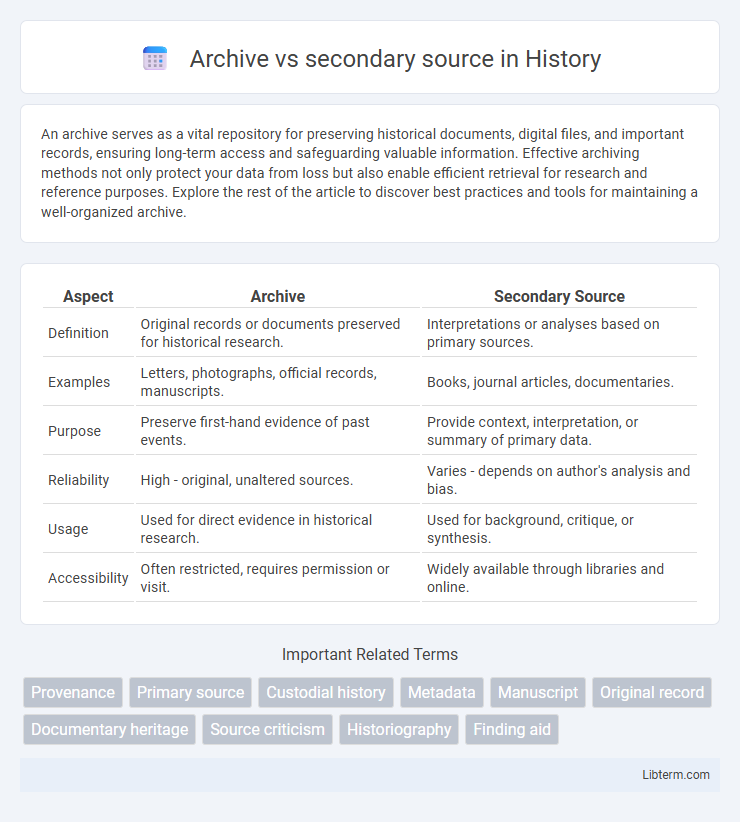An archive serves as a vital repository for preserving historical documents, digital files, and important records, ensuring long-term access and safeguarding valuable information. Effective archiving methods not only protect your data from loss but also enable efficient retrieval for research and reference purposes. Explore the rest of the article to discover best practices and tools for maintaining a well-organized archive.
Table of Comparison
| Aspect | Archive | Secondary Source |
|---|---|---|
| Definition | Original records or documents preserved for historical research. | Interpretations or analyses based on primary sources. |
| Examples | Letters, photographs, official records, manuscripts. | Books, journal articles, documentaries. |
| Purpose | Preserve first-hand evidence of past events. | Provide context, interpretation, or summary of primary data. |
| Reliability | High - original, unaltered sources. | Varies - depends on author's analysis and bias. |
| Usage | Used for direct evidence in historical research. | Used for background, critique, or synthesis. |
| Accessibility | Often restricted, requires permission or visit. | Widely available through libraries and online. |
Introduction to Archives and Secondary Sources
Archives contain original, primary documents such as letters, photographs, and official records that provide firsthand evidence of historical events. Secondary sources interpret, analyze, or summarize these primary materials, offering context and scholarly perspective. Understanding the distinction is crucial for effective research and accurate historical analysis.
Defining Archives: Meaning and Characteristics
Archives are collections of primary source documents that provide firsthand evidence of historical events, organizations, or individuals. They are characterized by their authenticity, originality, and permanent preservation, often maintained by institutions such as libraries, museums, or government agencies. Archives differ from secondary sources, which interpret or analyze primary data, by offering direct access to original records and materials essential for research and historical verification.
Understanding Secondary Sources: Overview
Secondary sources synthesize and analyze information derived from primary materials, providing interpretation and context that facilitate deeper understanding of historical events or original data. These sources include books, articles, reviews, and documentaries that discuss or critique archival records, making them crucial for research and academic study. Understanding secondary sources entails recognizing their role in offering comprehensive perspectives while being mindful of potential author biases and interpretations.
Key Differences Between Archives and Secondary Sources
Archives consist of original, primary documents and records that serve as firsthand evidence from a specific time period, while secondary sources interpret, analyze, or summarize those primary materials. Archives provide raw data such as letters, official records, and photographs, enabling direct access to historical facts, whereas secondary sources offer context, commentary, and synthesized narratives crafted by researchers or historians. The key difference lies in archives being original, unaltered materials, whereas secondary sources are derivative, relying on interpretation of archival or primary data.
Examples of Archival Materials vs Secondary Sources
Archival materials include original documents such as letters, photographs, official records, and manuscripts that provide firsthand evidence from a specific time period. Secondary sources consist of interpretations or analyses based on these original materials, such as textbooks, journal articles, and biographies. Examples of archival sources are census records and personal diaries, whereas secondary sources encompass history books and scholarly critiques.
Uses of Archives in Research
Archives serve as primary sources in research by providing original, authentic documents and records vital for historical accuracy and evidence-based analysis. Researchers utilize archives to access unpublished materials, official records, and firsthand accounts that support primary data collection and interpretation. Secondary sources interpret or analyze these original materials, but archives remain indispensable for verifying facts and generating new insights through direct examination of original content.
How Secondary Sources Aid Scholarship
Secondary sources synthesize and interpret primary archival materials, providing critical context and analysis that support scholarly research. They offer comprehensive overviews, highlight connections between disparate data, and help scholars identify trends and gaps in existing knowledge. By contextualizing original documents, secondary sources enable researchers to build informed arguments and advance academic discourse efficiently.
Evaluating Reliability: Archives vs Secondary Sources
Archives provide original, primary documents that offer firsthand evidence and are typically more reliable for accuracy and authenticity. Secondary sources interpret or analyze primary data, which may introduce bias or errors, making their reliability dependent on the author's credibility and methodology. Evaluating reliability involves assessing the provenance, accuracy, and context of archival materials versus the analytical perspective and potential subjectivity found in secondary sources.
Choosing Between Archives and Secondary Sources
Choosing between archives and secondary sources depends on the research objective and desired depth of information. Archives provide original, primary data such as manuscripts, official records, and firsthand accounts essential for authentic, detailed analysis. Secondary sources offer interpreted, summarized content like books or articles, useful for context, background, and broader understanding without direct access to original materials.
Conclusion: Integrating Archives and Secondary Sources in Research
Integrating archives and secondary sources enhances research depth by combining original, primary data with analyzed interpretations, ensuring comprehensive understanding and validation of findings. Archives provide authentic, unaltered evidence crucial for primary insights, while secondary sources offer contextual frameworks and scholarly perspectives that enrich analysis. Leveraging both resources maximizes accuracy, broadens scope, and strengthens the overall credibility of research outcomes.
Archive Infographic

 libterm.com
libterm.com